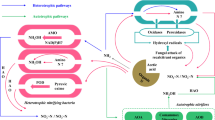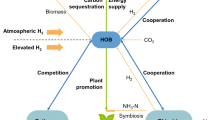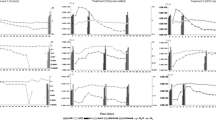Summary
Anaerobic conditions in soil affect plant productivity as well as organic matter and nutrient dynamics. Anaerobic processes often dominate biological and chemical features of flooded and poorly drained soils but in well-drained soils, anoxia is restricted to small zones and to limited periods. The anaerobic processes listed according to their approximate sequence of occurrence as the redox decreases are: Fe3+ and Mn4+ reduction, denitrification, fermentation, nitrate respiration, dissimilatory nitrate reduction to ammonium, sulfate reduction, carbon dioxide reduction, acetate splitting, and proton reduction. Two of the anaerobic processes, denitrification and fermentation of pollutant chemicals have been studied and recent results are summarized here. We describe the measurement of denitrification using a recirculating atmosphere of acetylene, provide quantitative information on the effect of moisture and oxygen on denitrification, and report on the oxygen concentration within soil aggregates measured by oxygen microelectrodes. The current hypotheses for the pathway leading from nitrate to the N−N bond and N2O are also presented. Recent work in our laboratory has shown a new reaction for the metabolism of some chlorinated organic chemicals. In this reductive dehalogenation, the ring Cl is replaced by a proton. An unusual organism which carried out this reaction has been enriched and isolated on 3-chlorobenzoate. These anaerobic reactions may be of further use in pollutant removal. With these new techniques and knowledge available, it is now possible to gain a better understanding of the biochemistry, physiology, ecology and diversity of the anaerobic organisms and their processes in soil.
Similar content being viewed by others
References
Averill B A and Tiedje J M 1982 The chemical mechanism of microbial denitrification. FEBS Lett. 138, 8–12.
Balch W E, Fox G E, Magrum L J, Woese C R, Wolfe R S 1979 Methanogens: reevaluation of a unique biological group. Microbiol. Rev. 43, 260–296.
Balderstrom W L, Sherr B, and Payne W J 1976 Blockage by acetylene of nitrous oxide reduction inPseudomonas perfectomarinus. Appl. Environ. Microbiol. 31, 504–508.
Boyd S A, Swelton D R, Berry D, and Tiedje J M 1983 Anaerobic biodegradation of phenolic compounds in digested sludge. Appl. Environ. Microbiol. 46, 50–54.
Garber E A E and Hollocher T C 198215N,18O-tracer studies on the activation of nitrite by denitrifying bacteria. Nitrite/water-oxygen exchange and nitrosation reactions as indicators of electrophilic catalysis. J. Biol. Chem. 257, 8091–8097.
Garcia J L and Tiedje J M 1983 Denitrification in rice soils.In Microbiology of Tropical Soils. Eds. H G Dommergues and H G Diem. Martinus Nijhoff Publ., The Hague.
Hollocher T C 1982 The pathway of nitrogen and reductive enzymes of denitrification. Antonie van Leeuwenhock J Microbiol. Serol. 48, 531–544.
Hynes R K and Knowles R 1978 Inhibition by acetylene of ammonia oxidation inNitrosomas europea. FEMS Microbiol. Lett. 4, 319–321.
Kaspar H F and Tiedje J M 1982 Anaerobic bacteria and processes.In Methods of Soil Analysis. Part 2. Ed. A L Page. Agron Monogr. 9, 989–1009, Amer. Soc. Agron., Madison, Wisc.
Kiener A and Leisinger T 1983 Oxygen sensitivity of methanogenic bacteria. Zbl. Bakt. Mikrob. Hyg. Abt Orig. C.
Parkin T B, Kaspar H F, Sexstone A J and Tiedje J M 1984. A gas-flow soil core method to measure field denitrification rates. Soil Biol. Biochem.In press.
Parkin T B, Sexstone A J and Tiedje J M 1984 Measurement and distribution of field denitrification rates determined by soil core and15N methods. Soil Sci. Soc. Am. J. (Submitted).
Parkin T B, Sexstone A J, Robinson J A and Tiedje J M 1984 A geostastical analysis of denitrification rates, denitrification enzyme activity, moisture, nitrate and pH in soil. Soil Sci. Soc. Am. J. (Submitted).
Parkin T B and Tiedje J M 1984 Application of a soil core method to investigate the effect of oxygen concentration on denitrification. Soil Biol. Biochem.In press.
Penn D J and Lynch J M 1982 The effect of bacterial fermentation of couch grass rhizomes andFusarium culmorum on the growth of barley seedlings. Plant Pathology 31, 39–43.
Revsbech N P and Ward D 1983 Oxygen microelectrode that is insensitive to medium chemical composition: use in an acid microbial mat dominated byCyanidium caldarium. Appl. Environ. Microbiol. 45, 755–759.
Sexstone A J, Parkin T B, and Tiedje J M 1984 Temporal response of soil denitrification rates to rainfall and irrigation. Soil Sci. Soc. Am. J. (Submitted).
Sexstone A J, Revsbech W P, Parkin T B and Tiedje J M 1984 Direct measurement of oxygen profiles and denitrification rates in soil aggregages. Soil Sci. Soc. Am. J. (Submitted).
Skinner F A 1975 Anaerobic bacteria and their activities in Soil.In Soil Microbiology A critical review. Ed. N Walker. pp 1–19. Butterworth and Co., London.
Smith K A 1980 A model of the extent of anaerobic zones in aggregated soils and its potential application to estimates of denitrification. J. Soil Sci. 31, 263–277.
Suflits J M, Horowitz A, Shelton D R and Tiedje J M 1982 Dehalogenation: novel pathway for the anaerobic biodegradation of haloaromatic compounds. Science 218, 1115–1117.
Suflita J M, Robinson J A and Tiedje J M 1983 Kinetics of microbial dehalogenation of haloaromatic substrates in methanogenic environments. Appl. Environ. Microbiol. 45, 1466–1473.
Suflita J M, Stout J and Tiedje J M 1984 Dechlorination of 2,4,5-trichlorophenoxyacetic acid (2,4,5-T) by anaerobic microorganisms. J. Agric. Food Chem. (Submitted).
Tiedje J M 1982 DenitrificationIn Methods of Soil Analysis, Part 2, Ed. A L Page. Agron Mongr. 9, 1011–1026, Am. Soc. Agron, Madison, Wisc.
Tiedje J M, Sexstone A J, Myrold D D and Robinson J A 1982 Denitrification: ecological niches, competition and survival. Antonie van Leeuwenhoek J. Microbiol. Serol. 48, 569–583.
Walter H, Keeney D R and Fillery I R 1979 Inhibition of nitrification by acetylene. Soil Sci. Am. J. 43, 195–196.
Yoshinari T and Knowles R 1976 Acetylene inhibition of nitrous oxide reduction by denitrifying bacteria. Biochem. Biophys. Res. Commun. 69, 705–710.
Zeikus J G 1980 Chemical and fuel production by anaerobic bacteria. Annu. Rev. Microbiol. 34, 423–464.
Author information
Authors and Affiliations
Additional information
Keynote address
Rights and permissions
About this article
Cite this article
Tiedje, J.M., Sexstone, A.J., Parkin, T.B. et al. Anaerobic processes in soil. Plant Soil 76, 197–212 (1984). https://doi.org/10.1007/BF02205580
Issue Date:
DOI: https://doi.org/10.1007/BF02205580
Key words
- Aggregate oxygen profile
- Anaerobic radii
- Anaerobiosis
- Anoxia
- Aromatic ring cleavage
- Clostridium
- Dechlorination
- Denitrification
- Denitrification pathway hypothesis
- Fermentation
- Fe3+Mn4+ reduction
- Methanogenic microorganisms
- 13N15N N−N bond N2O
- NO −3 respiration/dissimilatory reduction
- O2 consumption
- O2 diffusion coefficient
- O2 micro electrode
- Pesticides
- Reduction NO −3 NO −2 SO 2−4 CO2H+
- Soils flooded poorly and well drained
- Sulphate
- Xenobiotics




